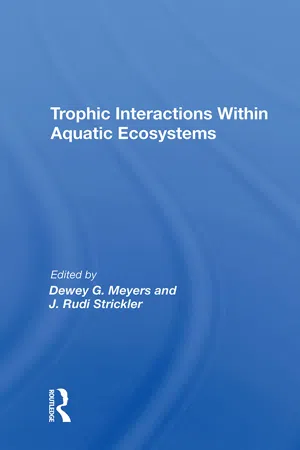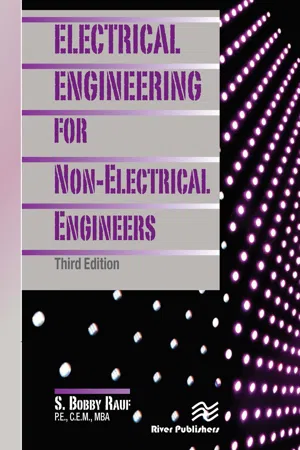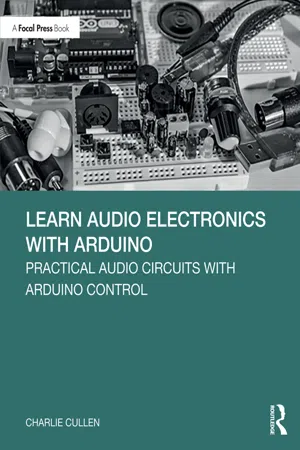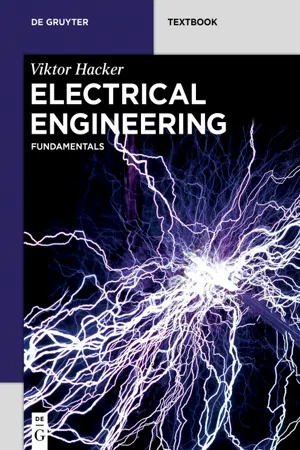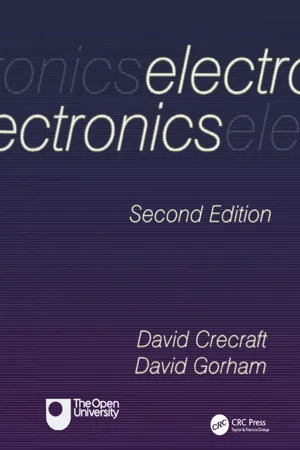Physics
Ohm's Law
Ohm's Law states that the current flowing through a conductor between two points is directly proportional to the voltage across the two points, and inversely proportional to the resistance between them. This relationship is expressed by the equation I = V/R, where I is the current, V is the voltage, and R is the resistance.
Written by Perlego with AI-assistance
Related key terms
Related key terms
1 of 4
Related key terms
1 of 3
11 Key excerpts on "Ohm's Law"
- eBook - ePub
- Ahmad Hemami(Author)
- 2017(Publication Date)
- CRC Press(Publisher)
Ohm’s law is probably the most fundamental as well as important relationship that defines the relationship between voltage and current in a circuit. Try to master the meaning of Ohm’s law before continuing any further.Ohm’s law: One of the most important laws of electric circuits: relationship between voltage across a component, the current in the component and the electric resistance exhibited by the component to the flow of electricity. For a simple resistor it is V = RI .Ohm’s law states that if the current in a resistor with a resistance R is I , then the voltage across the resistor (the voltage between the two ends of the resistor) is V , such thatV = R I(5.1) where R is in ohm, I is in amp, and V is in volt.This law also implies that if a voltage of V volt is applied to a resistance of R ohm, then the current is I ampere; that is, the current, voltage, and resistance between two points are always related to each other.Example 5.1 A lightbulb filament and the wires connecting it to a 12 V battery altogether have a resistance of 5 Ω. Find the current is in the lightbulb filament?SolutionSubstituting for the voltage and the resistance in Equation 5.1 leads to12 = 5 × II = 12 ÷ 5 = 2.4 AExample 5.2 If the same lightbulb as in Example 5.1 is connected to a 1.5 V battery, what is the current?Solution Resistance of the lightbulb does not change, because it is the physical property of the metallic wires involved. Thus,There are other meanings embedded in Ohm’s law, which we need to pay attention to.I = 1.5 ÷ 5 = 0.3 ANote, however, that when a filament is warmed and its temperature has changed, its resistance also changes. Here, for simplicity, we have assumed that the change in temperature is not high enough to affect the resistance.- The relationship between the voltage across a resistor and the current through that resistor is linear. That is, if the voltage doubles, the current doubles, too.
- By the same token, if the resistance of the resistor does not change, then, if the voltage drops in value (decreases), the current also decreases. Similarly, if the voltage increases, the current increases.
- S. Bobby Rauf(Author)
- 2021(Publication Date)
- River Publishers(Publisher)
Delta “Δ” load configuration, or vice and versa; conversion of complex circuits to Thevenin equivalent, Norton equivalent, two port networks, etc. However, these and many other advanced circuit analysis methods are outside the scope of this text.We will introduce the reader to two basic electronic devices, namely a diode and a transistor, their basic characteristics, and some of their applications. We will conclude this chapter with a pictorial “tour” of a typical electronic printed circuit board to allow the reader an opportunity to gain a measure of familiarity with basic electronic devices.Ohm’s Law
Ohm’s law was introduced, briefly, in Chapter 1. Ohm’s law stipulates that voltage, or voltage drop, in a DC (or AC) circuit is equal to the product of current flowing in the circuit and the resistance (or impedance) in the electrical circuit. In other words, voltage or voltage drop in an electrical circuit is directly proportional to the resistance (or impedance) of the circuit and the current flowing through it. Ohm’s law can, therefore, be stated mathematically as follows:V = I R , I =V R, o r R =V If o r D C C i r c u i t sEq. 2.1V ⇀=I ⇀Z ⇀,I ⇀=, o rV ⇀Z ⇀Z ⇀=f o r A C C i r c u i t sV ⇀I ⇀Eq. 2.2The first mathematical representation of Ohm’s law, in the form of Eq. 2.1 , pertains to DC circuits, and in this statement of Ohm’s law, all three parameters ―V, I, and R ― are scaler. On the other hand, mathematical representation of Ohm’s law, in the form of Eq. 2.2 applies to AC circuits, where voltage “V” and current “I” are vectors or complex entities and R, as always, is scalar. Note that the symbols with “half-arrows” above them denote complex AC, or vector, entities. These half arrows are shown here to introduce the reader to this method for representing vector or complex entities. Later in this text, vector or complex entities will be represented mostly in bold fonts. As one examines the statement of Ohm’s law in the form of Eqs. 2.1 and Eqs. 2.2 , it becomes obvious that the Ohm’s law can be interpreted and applied in several ways. This fundamental aspect of Ohm’s law, its versatility, and wide application will become more evident through various circuit analysis problems in this chapter, and others in this text, beginning with Example 2.1- eBook - ePub
Learn Audio Electronics with Arduino
Practical Audio Circuits with Arduino Control
- Charlie Cullen(Author)
- 2020(Publication Date)
- Focal Press(Publisher)
scales and symbols often take more time to learn than equations, so terms will be explained whenever they are first introduced.Ohm’s Law is a simple equation to work with and forms the basis of all electrical circuit analysis. We can apply the equation in different ways, where we can use any two of the quantities involved to determine the third by simply rearranging the terms:V o l t a g e , V = I R C u r r e n t , I =(3.2)V RR e s i s t a n c e , R =V IThis rearrangement of quantities is a very important analysis tool, and we can use our circuit example from Figure 3.1 to show how Ohm’s Law can derive the correct size of resistor needed to limit the current in the circuit to 500mA.3.1.1 Worked example – calculating a resistor valueThis example uses the simple circuit from Figure 3.1 , though it has no practical use other than to introduce Ohm’s Law for calculation.Q1 :A single resistor is connected in a circuit powered by a 5V voltage source (from an Arduino). As the Arduino has a maximum output current of 500mA, a resistance value is needed to limit the output current to this level – what would be a suitable value for this resistor?V = 5 V , I = 500 mAR e s i s t a n c e , R =V I=5 0.5= 1 0Answer : A suitable resistor value for the circuit would be 10Ω .Notes:
The only issue in this example is the scaling factor of milliamps for current, which requires 500mA to be scaled to 500 x 10−3 = 0.5A .The example above is simple enough, though of no actual practical use – the Arduino is limited by the USB protocol of the computer supplying it, so it cannot exceed 500mA even if the resistance in the circuit was lowered to 5Ω (giving a theoretical current of 1A). It is also important to note that all Arduino output pins are limited to 40mA and driving them beyond this current will damage the Arduino (the +5V power pin is not directly connected through the microcontroller so it is not limited in this way). The purpose of this circuit is to show how straightforward Ohm’s Law is to use, providing you know two of the three quantities and pay attention to any scaling factors involved. As you progress through the book, we will use Ohm’s Law extensively in our circuit analysis so it will help to spend some time looking at equation (3.2) - eBook - ePub
OAT Prep Plus 2023-2024
2 Practice Tests + Proven Strategies + Online
- (Author)
- 2023(Publication Date)
- Kaplan Test Prep(Publisher)
ε. Thus, a real-world cell provides less voltage than an ideal cell.Resistance
Resistance and Ohm’s law
Resistance (R) can be thought of as the opposition to the flow of an electric current that occurs within a conductor. This opposition takes the form of an energy loss or drop in potential. Ohm’s law states that the voltage drop across a resistor is proportional to the current it carries, with R being the proportionality constant known as resistance:This equation applies to a single resistor within a circuit, to any part of a circuit, or to an entire circuit. Note that the current is unchanged as it passes through the resistor since no charge is lost inside the resistor. The SI derived unit of electrical resistance is the ohm (Ω).Resistance of a conductor
The resistance of an object depends on its size, the type of material from which it is made, and its temperature. Resistance of a wire depends on three factors: length, cross-sectional area, and resistivity. These three factors give the following equation for resistance of a conductor:where R is resistance in ohms, L is the length in meters, A is the cross-sectional area in m2 , and ρ is the resistivity of the material. Temperature is also a factor in determining resistance.Length (L)
Resistance is directly proportional to length of a wire. A longer conductor means greater resistance because there is a longer path that current-carrying electrons must travel. For example, consider two wires that are identical in every respect except that one is twice as long as the other. The longer wire will have twice the resistance of the shorter wire because the electrons need to travel twice as far.Cross-sectional area (A)
The resistance of a conductor is inversely proportional to its cross-sectional area. An increase in cross-sectional area causes a decrease in resistance because there is an increase in the number of conduction paths electrons can follow. For example, consider two wires that are identical in every respect except that one has twice the cross-sectional area of the other. The thinner wire will have twice the resistance of the thicker wire. - eBook - ePub
- Anupam Garg(Author)
- 2012(Publication Date)
- Princeton University Press(Publisher)
Our second theme, therefore, will be to describe a few selected sources of emf. Our description will have very much of a “how things work” flavor, since the physics of the devices is highly varied and outside the theory of electromagnetism per se. An understanding of these sources is nevertheless very useful, as the notion of an emf tends to remain somewhat mysterious without it.FIGURE 17.1. Current through (a) a general conductor, (b) a uniform wire.The discussion of emf and Ohm’s law naturally leads to our last theme, linear circuits. We will discuss these very briefly, mainly to highlight the approximations and the limits of their validity.110 Ohm’s law
The fundamental feature of metals is the existence of free or delocalized electrons which can conduct electricity. To solve Maxwell’s equations in the presence of current-carrying bodies, one needs a constitutive equation connecting the current to the fields in the body. This is provided by Ohm’s law, which Ohm discovered through extensive experiments. For a body carrying a steady current, the law takes the local formHere, j and E are the current density and electric field at any point in the body, and σ is known as the conductivity of the material in question. It is necessarily a positive quantity, since the electric field inside the body accelerates the electrons and increases their kinetic energy. In steady state, this increased energy must be dissipated as heat. The rate of dissipation per unit volume is easily shown to be and its positivity implies σ > 0.Conductivity has dimensions of inverse time in the Gaussian system and may therefore be quoted in sec−1 . It is equally common to give the inverse of the conductivity, known as the resistivity:This has units of sec in the Gaussian system and ohm m in the SI system. One ohm m is a rather high resistivity, however, so one often sees the derived unit micro-ohmcentimeter, written μ ohm cm. The conversion factor for resistivity isOhm’s law also applies to materials other than metals, e.g., semiconductors and electrolytic solutions. When these are included, resistivities can vary over a wide range. At 273 K, the resistivities of pure copper, tin, and bismuth are 1.6, 11, and 110, all in μ ohm cm, that of germanium is 200 ohm cm, and of seawater is ~25 ohm cm (note the missing micro). By varying the temperature and doping, semiconductor resistivities can be made to vary over 13 orders of magnitude, from 10−2 to 1011 ohm cm. We shall develop a physical model of conduction in chapter 18 - eBook - ePub
- Trevor Linsley(Author)
- 2014(Publication Date)
- Routledge(Publisher)
resistance measured in ohms, to commemorate the famous experimenter George Simon Ohm, who was responsible for the analysis of electrical circuits. The symbol Q represents an ohm.In 1826, Ohm published details of an experiment he had made to investigate the relationship between the current passing through and the potential difference between the ends of wire. As a result of this experiment he arrived at the following law, known as Ohm’s law. ‘The current passing through a conductor under constant temperature conditions is proportional to the potential difference across the conductor’.V = I × R (V)Transposing this formula, we also haveAn electric heater when connected to a 230 V supply was found to take a current of 4 A. Calculate the element resistance.EXAMPLE 1
The insulation resistance measured between phase conductors on a 400 V supply was found to be 2 MΩ Calculate the leakage current.EXAMPLE 2
When a 4Ω resistor was connected across the terminals of an unknown d.c. supply, a current of 3A flowed. Calculate the supply voltage.EXAMPLE 3
V = I × R (V)V =3A × 4Ω = 12VResistivity (symbol p — the Greek letter ‘rho’)
The resistance or opposition to current flow varies for different materials, each having a particular constant value. If we know the resistance of say one metre of a material, then the resistance of five metres will be five times the resistance of one metre.The resistivity of a material is defined as the resistance of a sample of unit length and unit cross-section. Typical values are given in Table 8.3 - eBook - ePub
Electrical Engineering
Fundamentals
- Viktor Hacker, Christof Sumereder(Authors)
- 2020(Publication Date)
- De Gruyter Oldenbourg(Publisher)
Voltage can cause electric current: If there is a voltage between two particles and these two particles are connected through a conductor, current flows. (More specifically: There is an electric field between the two particles. This field exerts force on the free charge carriers, which causes them to move.)Voltage is connected to force: Two particles, with an electric voltage between them, carry a different number of positive and negative electric charges, respectively; therefore, they are positively and negatively charged relative to one another. The respective surplus charges exert forces of attraction on each other.Technical generation of voltage:-
Electric charges are separated by induction (generator, transformer) due to magnetic energy.
-
A chemical reaction separates electric charges in the galvanic cell.
-
Heat separates electric charges in the thermocouple.
-
Radiant energy of the light separates electric charges in the photovoltaic cell (industrially in photovoltaic panels).
-
Pressure separates electric charges in some piezoelectric crystals (e.g. quartz).16
1.10 Ohm’s law
Ohm’s law describes a linear correlation in certain electric conductors between voltage drop V and the electric current I which is flowing through the conductors at constant temperature:V = R ⋅ IV Voltage in VR Electrical resistance in Ω (Ohm)I Electric current in AThe resistance R ideally17 is constant, regardless of the magnitude of the current. If this is the case, we talk about linear circuits.1.10.1 Resistance R and conductance G
The resistanceRof a conductor depends on the material and the spatial dimensions of the conductor. To measure the resistivity of the material, the specific resistance is defined as the resistance of a cube with edges 1 m in length.Figure 1.16: Resistance R.The unit of resistance is a quantity derived from I andV. A conductor has a resistance of1 Ωwhen a voltageV = 1 Vdrives a current ofI = 1 Athrough the conductor.18The technically used resistors can generally be divided into two groups: wire resistors and sheet resistors. The materials of the wire filaments or coatings, usually attached to cylindrical ceramic bodies, have specific resistances with low temperature dependence. The resistance is determined by measuring current and voltage. - eBook - ePub
Circuit Analysis with PSpice
A Simplified Approach
- Nassir H. Sabah(Author)
- 2017(Publication Date)
- CRC Press(Publisher)
2 Fundamentals of Resistive CircuitsObjective and Overview
This chapter introduces (1) the two ideal circuit elements of dc circuits, namely, resistors and sources; (2) the two basic circuit laws, namely, Kirchhoff’s current law (KCL) and Kirchhoff’s voltage law (KVL); and (3) the two basic connections between circuit elements, namely, series and parallel connections.The nature of electrical resistance is first explained using a simplified model, following which, the very basic Ohm’s law defining an ideal resistor is presented. Ideal, independent and dependent, voltage and current sources are then discussed, with emphasis on their defining and essential properties.Kirchhoff’s laws are introduced as laws derived from conservation of charge and conservation of energy, but which provide a much simpler means of analyzing circuit behavior. Series and parallel connections of circuit elements are then discussed and linked to Kirchhoff’s laws.PSpice simulations are introduced in this chapter and are included in all numerical examples, whenever appropriate, to illustrate and verify the results of analytical solutions. This chapter concludes with a very helpful problem-solving approach and illustrating it with examples.⋆ 2.1Nature of ResistanceConcept: Resistance is fundamentally due to impediments to the movement of current carriers in a conductor under the influence of an applied electric field.A sample of a metallic conductor typically consists of a large number of crystals in which the rest positions of the metal atoms at 0 K are arranged in a regular manner that is characteristic of the type of crystal. At temperatures above 0 K, (1) the crystal atoms vibrate, in randomly oriented directions, about their rest positions, with an amplitude of vibration that increases with temperature, and (2) some electrons, referred to as conduction electrons have sufficient energy to detach from their parent atoms and move freely in the crystal, in randomly oriented directions, at thermal velocities of the order of 107 - eBook - ePub
- Daniel McBrearty(Author)
- 1998(Publication Date)
- Newnes(Publisher)
Why do some materials conduct electricity, while others don’t? Some materials are populated by good and careful atoms which don’t lose their electrons easily (and probably feel ashamed if they do). Hence the itinerant population is low. The few free electrons that exist tend to sit miserably in one place, having given up hope of ever finding a home. These are insulators, typically air, rubber or the fibreglass backing of a circuit board. In other materials atoms are positively feckless. There are many free electrons and should some charged material come near they move accordingly. How do they know? They feel the voltage. These are conductors. Most metals are conductors. We use copper a great deal, gold where corrosion could be a problem, and sometimes aluminium or other metals for housing equipment.Resistance
Some materials fall into a kind of grey area between being conductors and insulators. We can use these to make resistors. It’s as if the material was a kind of mud; if we make the mud thicker electrons move less easily. The resistance of a given piece of a material depends on ‘how thick the mud is’ (the ‘resistivity’ of the material) and its geometry. Making it thinner increases, and doubling or tripling length doubles or triples, its resistance.Ohm’s Law
The unit for resistance is the ohm, or, and the symbol in equations is R. Now we come to the most important equation in electronics:(2.1a)with V in volts, I in amps, R in ohms. This is Ohm’s Law. We will use it so much that it bears being rewritten in its two other forms:(2.1b)and:(2.1c)These are used so frequently that you need to know them by heart. Ohm’s Law tells us that placing a steady voltage across a material causes a proportional steady current to flow.Even insulators and conductors have resistance. Insulators have very high resistance; tens or hundreds of MΩ or more, so that for the normal voltages that we use an unmeasurably small current flows. If the voltage is raised to sufficiently high levels, usually at least a kV, a condition called ‘breakdown’ occurs; electrons are blasted free from atoms within the structure of the material, and its essential nature is changed. You will know if this happens; there is a nasty burning smell, and things stop working. It is a condition which we try to avoid.Conductors are the opposite; their resistance is very low, small fractions of an ohm typically. The commonest conductor that we use is copper. We cannot normally measure the voltage across a piece of copper wire, unless it is long. We can find out, from catalogues and so on, the resistance per metre of any given type of wire; this depends on the wire, but figures of around 0.1 Ω/m are typical. Occasionally we need to find this out and calculate the total resistance of a length of cable when our wires are very long, in a large system. The wire will also have a maximum current rating, which is what we can pass through it before the amount of heat generated in it becomes dangerous to its structure. The insulating material around it may melt, causing it to short to things that it shouldn’t, or the conductor itself. We only need know that we should stay comfortably within the maximum rated current for a conductor. In essence, anything can be destroyed with too much voltage/current. - eBook - ePub
Lessons from Nanoelectronics
A New Perspective on Transport
- Supriyo Datta(Author)
- 2012(Publication Date)
- WSPC(Publisher)
These Lectures, however, are not about the amazing feats of microelectronics or where the field might be headed. They are about a less-appreciated by-product of the microelectronics revolution, namely the deeper understanding of current flow, energy exchange and deviceoperation that it has enabled, based on which we have proposed what we call the bottom-up approach. Let me explain what we mean.According to Ohm's Law, the resistance R is related to the cross-sectional area A and the length L by the relationρ being a geometry-independent property of the material that the channel is made of.The reciprocal of the resistance is the conductance which is written in terms of the reciprocal of the resistivity called the conductivity.Our conventional view of electronic motion through a solid is that it is "diffusive," which means that the electron takes a random walk from the source to the drain, traveling in one direction for some length of time before getting scattered into some random direction as sketched in Fig.1.3. The mean free path, λ that an electron travels before getting scattered is typically less than a micrometer (also called a micron = 10-3 mm, denoted µm) in common semiconductors, but it varies widely with temperature and from one material to another.Fig.1.3. The length of the channel of an FET has progressively shrunk with every new generation of devices (“Moore’s Law”) and stands today (2010) at ~ 50 nm, which amounts to a few hundred atoms!It seems reasonable to ask what would happen if a resistor is shorter than a mean free path so that an electron travels ballistically ("like a bullet") through the channel. Would the resistance still obey Ohm's Law? Would it still make sense to talk about its resistance? These questions have intrigued scientists for a long time, but even twenty five years ago one could only speculate about the answers. Today the answers are quite clear and experimentally well established. Even the transistors in commercial laptops now have channel lengths L - eBook - ePub
- David Crecraft(Author)
- 2018(Publication Date)
- CRC Press(Publisher)
It can be made to measure large currents by connecting shunt resistors in parallel with the movement. It can be made to measure voltages by connecting resistors in series with the movement. (The ohms-per-volt figure for a voltmeter is the total meter resistance divided by the full-scale deflection voltage. It is a figure of merit for a moving-coil voltmeter.) Resistance measurement is achieved by applying a known voltage to the unknown resistor and measuring the current flow. This results in a non-linear resistance scale. 9. An A-D converter and display can form a low-sensitivity voltmeter. An electronic amplifier preceding the converter allows the sensitivity to be increased. Different voltage gains of the amplifier are used to establish the different voltage ranges. Current is measured by passing the current through a low-resistance resistor and measuring the voltage drop across it. Resistance is measured by passing a constant current through the unknown resistor and measuring the voltage drop across it. This results in a linear resistance scale, convenient for conversion to the read-out. 1.5 KIRCHHOFF’S LAWS 1.5.1 Introduction The rest of this chapter describes some useful methods of circuit analysis. The treatment is confined to d.c. circuits, but the same methods are used for a.c. circuit analysis throughout the rest of this book. We start with two simple, and intuitively obvious, laws known as Kirchhoff’s laws. 1.5.2 Kirchhoff’s current law Consider Fig. 1.30. Points such as A, B and C, where two or more circuit components are connected together (with connections of negligible resistance) are called nodes. Kirchhoff’s current law is a formalization of the implications for circuit analysis of the fact that current cannot accumulate at a circuit node, so that the current flowing towards the node must be equal to the current flowing away from it
Index pages curate the most relevant extracts from our library of academic textbooks. They’ve been created using an in-house natural language model (NLM), each adding context and meaning to key research topics.
Explore more topic indexes
Explore more topic indexes
1 of 6
Explore more topic indexes
1 of 4
